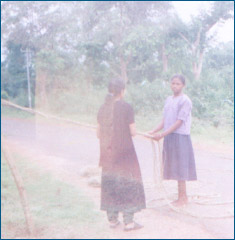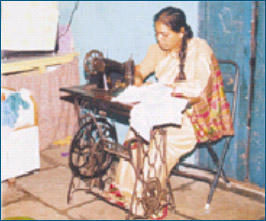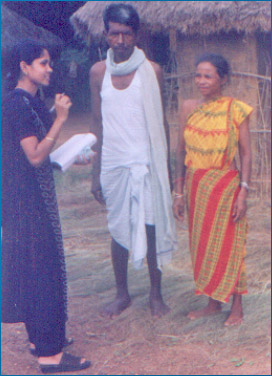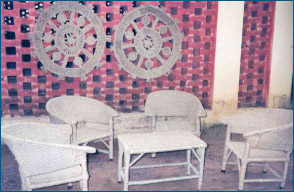Seeking a socio-economic space from the realms of wilderness!!
Sucess Stories:-
 Laxmi SHG was formed in 2001 under the guidance of SEBA, in Gadadeulia village of Mayurbhanj district of Orissa state of India. Most of the members were Sabai workers and dependent on money-lenders for their credit requirements. The SHG now actively participates in a number of activities in the village. Many of the members who used to put their thumb impression in place of signatures, have now learnt to put their signatures. One of the members, Taramani is a widow with a daughter of 5 years. After the death of her husband, she was left with no one to support her. With the help of the SHG, Taramani could get back her husband's share of property, which was her rightful due. She has also taken up a job and has become economically independent. The SHG is also actively involved in health care activities in the village. It has acquired on lease 12 acres of barren land for cultivation of sabai grass. From the grass they were preparing rope and sold it collectively at the weekly market. For this, the SHG has been sanctioned a loan of Rs. 80,000 (US$ 2000) from a local commercial bank branch.
Laxmi SHG was formed in 2001 under the guidance of SEBA, in Gadadeulia village of Mayurbhanj district of Orissa state of India. Most of the members were Sabai workers and dependent on money-lenders for their credit requirements. The SHG now actively participates in a number of activities in the village. Many of the members who used to put their thumb impression in place of signatures, have now learnt to put their signatures. One of the members, Taramani is a widow with a daughter of 5 years. After the death of her husband, she was left with no one to support her. With the help of the SHG, Taramani could get back her husband's share of property, which was her rightful due. She has also taken up a job and has become economically independent. The SHG is also actively involved in health care activities in the village. It has acquired on lease 12 acres of barren land for cultivation of sabai grass. From the grass they were preparing rope and sold it collectively at the weekly market. For this, the SHG has been sanctioned a loan of Rs. 80,000 (US$ 2000) from a local commercial bank branch. From No where to Some where

It looked like the world had ended for Sumitra Singh, when her husband deserted her a few years ago. She lived in Bhadosolo, Badasahi, Mayurbhanj, Orissa State of India. She was unemployed, unskilled, depressed and was an additional burden on her already poor parents. Faced with an uncertain future, Sumitra started showing withdrawal symptoms, unwilling to interact even with known people. The persistence of a field worker of SEBA , promoted by BGB Bank helped in introducing Sumitra to the SHG fold and she joined Laxmi Mahila samiti (SHG) IN 2001. Initially, she had to borrow Rs. 50 (US $ 1.2) every month to even make the compulsory savings with the SHG. She picked up some sewing work from neighbours, fetching paltry sums at times.Break through for Sumitra came, with an exposure programme by SEBA at Baripada in 2002, She picked up tailoring skills through the programme. The SHG gave her a loan to get a stitching machine. Baitarani Gramya
Bank financed the SHG.In a period of 2 to 3 years, she started earning around Rs. 700 per month (US $ 18). Bleakness and uncertainty slowly yielded to hope and confidence in Sumitra’s life. She started taking up useful activities like midwifery and postnatal help to the local women. She learned Rangoli block making and started producing artistic designs, which caught the fancy of a lady from Guwahati, who visited the village. Confident enough to forge friendship with an out state person, Sumitra even managed to sell Rangoli making kits. “ I earned Rs. 30,000 (US $ 800) through rangoli kits !†Sumitra told us, when we visited her in November 2005.Now, Sumitra is an animator with an NGO. She earns a monthly income of Rs 2,500 (US $ 60), and has done up her house with a lick of fresh paint and with amenities like a gas stove!
Gender power transforming villages
 Shanti SHG was formed with 20 women members under the guidance of SEBA, in the year 2003 in Khasadihi village of Mayurbhanj district of Orissa in India. The SHG has led to empowerment of the women members in this remote village. This emancipation process has also helped them to come out of the clutches of money lenders. HERE is one example of what the might of collective action can do…..The local practices largely led by the feudal lords ensured that poor hardly be given a Patta - an ownership certificate for the land they owned. There was no system of issuing Patta lands (land title) in the village since the last 10 years. With unified women power and persistent persuasion with local village leaders and community leaders the SHG members ensured issuance of Patta land to 43 poor families in the village. Subsequently about 17 houses have been constructed with support from an aided programme which had earlier bypassed the needy poor. The SHG members have also ensured that potable water connection is made available in the village as also good access road to the village. This SHG is now successfully managing a production unit for manufacturing Batik printed clothes, wall-hangings from Sabai grass, etc. which are being sold in the local markets as well as outside.
Shanti SHG was formed with 20 women members under the guidance of SEBA, in the year 2003 in Khasadihi village of Mayurbhanj district of Orissa in India. The SHG has led to empowerment of the women members in this remote village. This emancipation process has also helped them to come out of the clutches of money lenders. HERE is one example of what the might of collective action can do…..The local practices largely led by the feudal lords ensured that poor hardly be given a Patta - an ownership certificate for the land they owned. There was no system of issuing Patta lands (land title) in the village since the last 10 years. With unified women power and persistent persuasion with local village leaders and community leaders the SHG members ensured issuance of Patta land to 43 poor families in the village. Subsequently about 17 houses have been constructed with support from an aided programme which had earlier bypassed the needy poor. The SHG members have also ensured that potable water connection is made available in the village as also good access road to the village. This SHG is now successfully managing a production unit for manufacturing Batik printed clothes, wall-hangings from Sabai grass, etc. which are being sold in the local markets as well as outside.Women entrepreneurs of Manchabandha - Breaking traditional thoughts

Tensions prevail between Manju and her husband Bansi primarily due to low income of the family. Bansi runs a shop which does not draw enough customers as the stock he keeps is limited. Manju discusses her problem with some other women. These women, too, face the same problem. An enlightened person of the village tells Manju about the formation of SHGs in many places for solving the day-to-day problems of women. She discusses the idea with other women and they decide to form an SHG called Ma Ambica SHG. SHG consist of 20 women members. They have no money to save. Hence, each membercollects 4 kilos of rice per month per member and allows the needy members to borrow from the
accumulated stock. The borrowing member is required to repay whatever she had borrowed along with 3 kilos of rice per quintal per month as interest. In 1999 they sold their stock for Rs. 7,000 (US$ 165) and switched over to cash savings of Rs. 50 per month per member. They continued to deposit the money in the local bank. Subsequently, Bank sanctioned a loan of Rs. 20,000 (US$ 250) against the accumulated savings of the group of Rs. 10,000 (US$ 125). The members borrow from the group at 3% monthly interest. Some of the members of the group have utilised the loans to increase the stocks of their own or husbands' small shops. They could make a profit of 30% to 40% from the extra stocks created form loans. Now they have started a joint Production center in Sabai craft with the involvement of the group members to generate more income under the guidance of SEBA.

